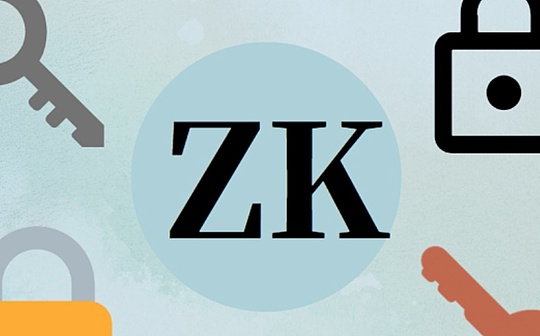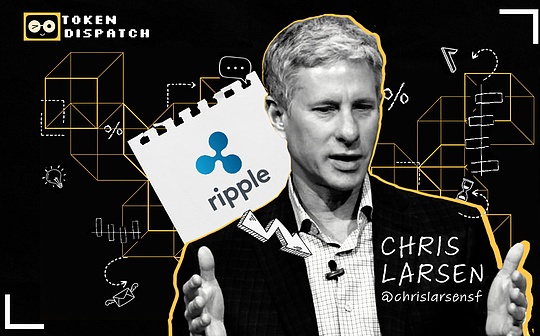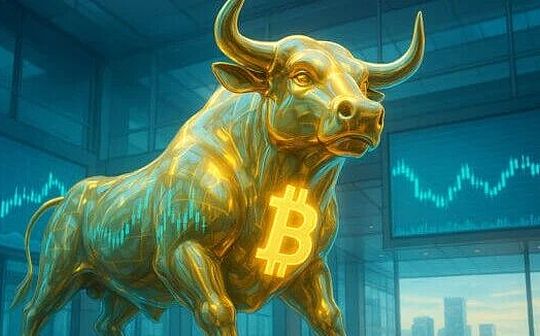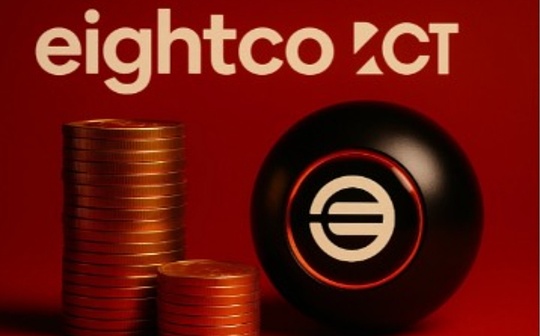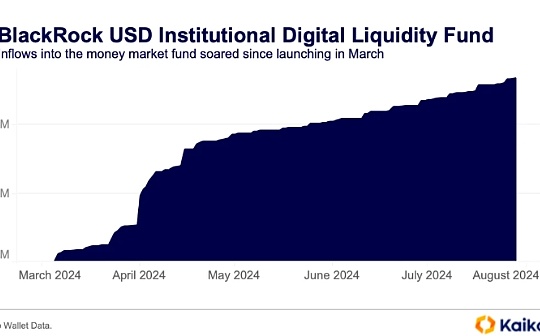
Source: Kaiko Research; Compilation: Baishui, Bitchain Vision
Despite encouraging U.S. inflation data last week, the cryptocurrency market remains volatile.According to the latest quarterly report, Goldman Sachs and Morgan Stanley held large positions in various Bitcoin ETFs as of the end of the second quarter.In addition, Binance reached a settlement with India’s financial intelligence agencies, hoping to return to the Indian market.This week, we will discuss:
-
Prospects of crypto projects investing in treasury bonds;
-
ETH Gas fees hit their lowest point in years;
-
Investor interest in AI token projects remains sluggish.
Trends for the week
Rate cuts are unlikely to limit the attractiveness of tokenized Treasuries.
BlackRock’s on-chain tokenized fund BUIDL (BlackRock Dollar Institutional Digital Liquidity Fund) is one of many funds launched in the past 18 months, providing investment in traditional debt instruments such as U.S. Treasury bonds.It quickly became the largest on-chain fund at Asset Management Scale (AUM).Launched in March 2024 with Securities, the fund has attracted more than $520 million inflows to date.
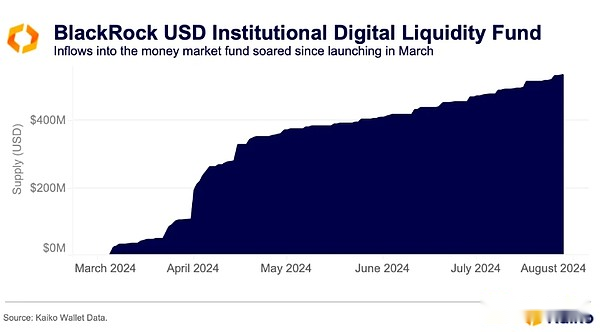
Most of these funds are invested in short-term U.S. debt instruments.Other top funds include Franklin Templeton’s FBOXX, Ondo Finance’s OUSG and USDY, and Hashnote’s USYC.Each fund’s yield is consistent with the federal funds rate.
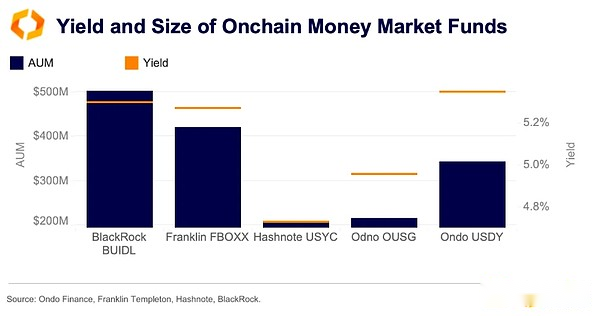
As the speculation of these tokenized funds continues to heat up, the on-chain capital flow and the secondary market of related tokens have increased activity.Ondo Finance’s governance token ONDO has experienced its biggest surge in transactions, coincided with its announcement of partnership with BlackRock’s BUIDL.The price of ONDO hit a record high of $1.56 in June amid surge in BUIDL capital inflows and growing interest in on-chain funds.However, the hype has gradually faded since then, and capital inflows may face resistance as the U.S. interest rate environment changes.
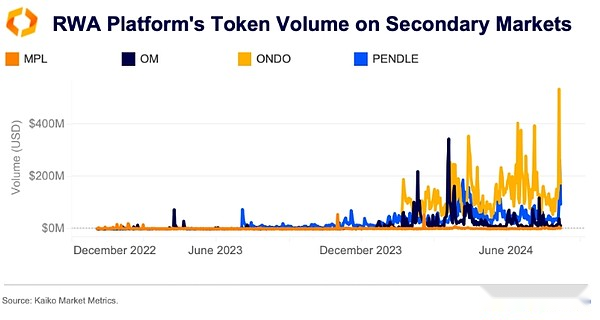
Since the August 5 sell-off, the Fed has been lagging behind the situation and needs to cut interest rates more aggressively to avoid a recession.The market is currently expected to cut interest rates by 100 basis points this year.
U.S. inflation data were weaker than expected last week, solidifying expectations for a rate cut in September.However, interest rate cuts do not necessarily mean easing monetary policy.If the Fed lowers its nominal interest rate, but inflation drops at the same or faster rate, the real interest rate (the inflation-adjusted nominal interest rate) may remain stable or even rise.
In fact, even as the Fed maintains nominal interest rates, the real federal funds rate adjusted for the Producer Price Index (PPI), an indicator of corporate pricing power, has risen moderately this year.

If real interest rates remain stable, the potential stimulus effect of the Fed’s rate cut may be weaker than expected.In this case, U.S. Treasury bonds may still be attractive compared to risky assets, as investors may prefer liquidity and security over risk.
Data worth paying attention to
The impact of a sharp drop in Ethereum Gas fees on supply.
Ethereum’s gas fees have recently hit a five-year low, thanks to increased Tier 2 activity and a Dencun upgrade in March, which lowered Tier 2 transaction fees.This fee reduction has an impact on ETH becauseLower fees mean less ETH is destroyed, thus increasing the supply of tokens.Therefore, the total supply of ETH has been continuing to rise since April.Despite demand drivers such as spot ETH ETFs, this growing supply could curb potential price increases in the near term.
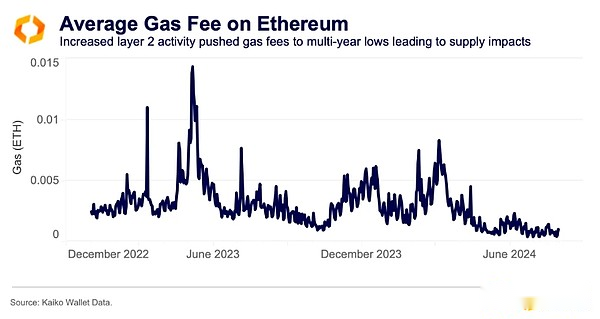
AAVE mortgage demand cools down.
Aave V3 is TVL’s largest DeFi lending protocol, with liquidation of over $260 million in amid a cryptocurrency price plunge and a wide-scale market sell-off that began on August 5, after which demand for Aave V3 mortgages cooled down in August.
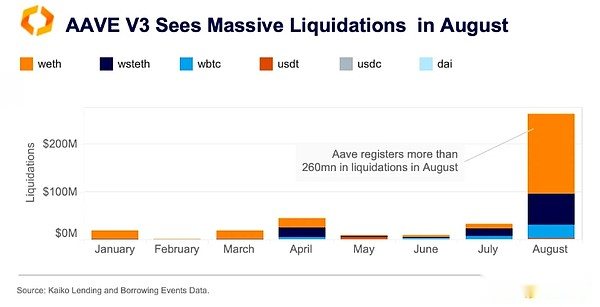
Aave V3 recorded a net inflow between May and July, with borrowing exceeding repayments.In July, stablecoin borrowings hit a year-on-year high of $1.4 billion, while repayments totaled $1.2 billion, with net inflows reaching about $200 million.However, the trend has reversed after the recent selloff, with net outflows exceeding $200 million since the beginning of the month.
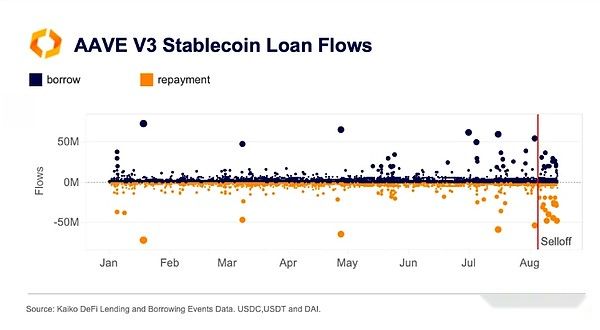
AI crypto token mergers strive to rekindle market interest.
Last month, three AI-focused crypto projects—Fetch.AI, SingularityNET and Ocean Protocol—started the first phase of combining their native tokens into one token, called Artificial Intelligence (ASI) generationcurrency.The merger, originally announced in March, is part of a broader plan to develop a new AI platform that provides “a decentralized alternative to existing AI projects controlled by large tech companies.”
Since July, the total market share of SingularityNET’s AGIX, Ocean Protocol’s OCEAN and Fetch.AI’s FET tokens has increased from 30% to 40%.However, our transaction-by-transaction data show thatThis growth was driven primarily by an increase in selloffs, suggesting that traders view the merger as a risk event.
Overall demand for AI tokens has dropped sharply since the beginning of the second quarter.In early August, weekly trading volume plummeted to $2 billion, a six-fold drop from its multi-year high of more than $13 billion in the first quarter.
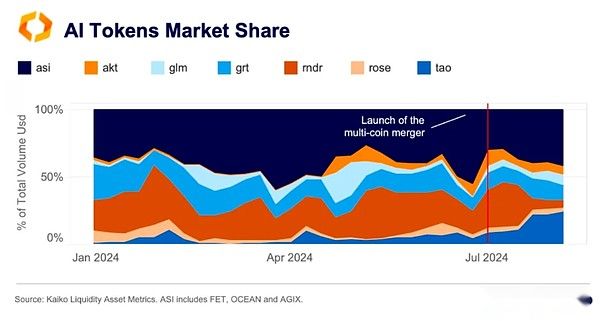
Cryptokens related to AI are related to projects that use AI to improve security, user experience, support decentralized exchanges or provide image and text generation services.However, their 60-day correlation with chip maker Nvidia (NVDA), which is widely regarded as betting on a potential AI-related boom.Currently, the correlation hovers around 0.1-0.2, down from the peak of 0.3-0.4 in March.By contrast, their correlation with Bitcoin is still strong, with correlations ranging between 0.5 and 0.7 as of early August, suggesting that traders view these items as high beta crypto bets.
FDUSD’s market share on Binance hits an all-time high.
At the end of July, stablecoin FDUSD hit a record high of 39% on Binance, reversing the continued downward trend over the past three months.This growth is striking as the exchange reintroduced zero commissions for FDUSD trading pairs for both regular and VIP-1 users as early as April.
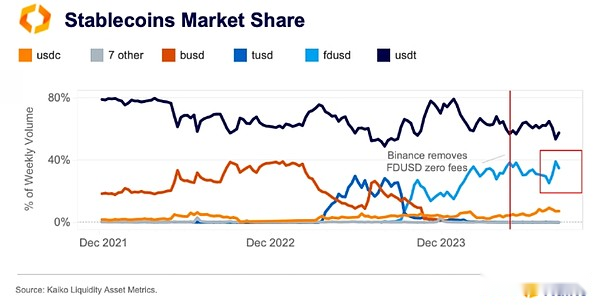
A closer look at transaction-by-transaction data shows that the surge in FDUSD volume is mainly due to increased purchases of Binance’s four major FDUSD pricing pairs, as well as rotations of other stablecoins, especially Tether’s USDT.
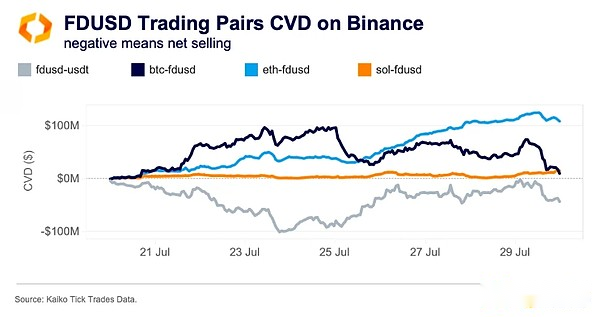
This is especially interesting as Bitcoin suffered a strong sell-off in Binance’s USDT market during the same period (not charted).
First Digital USD (FDUSD), regulated by Hong Kong, was launched in June 2023 and will soon begin trading on Binance without pending orders and acceptance fees.By 2024, its daily trading volume soared to an average of $6.5 billion, more than six times the trading volume of the second largest stablecoin, USDC ($1 billion).However, FDUSD’s success depends heavily on Binance as it only trades on the platform and is closely related to its fee policy.
The Japanese market leads the cryptocurrency sell-off.
The Bank of Japan’s interest rate hike at the end of July was a precursor to the surge in financial market volatility in August.The cryptocurrency market plunged along with the stock market as investors panicked as changing interest rate environments in Japan and poor U.S. economic data.
The consequences of the first weekend of August immediately hit the cryptocurrency market.Throughout the weekend, BTC fell more than 12%, and by Monday morning European time, it fell below $50,000.During the sell-off, volumes on Japanese cryptocurrency exchanges surged, especially Bitbank and Bitflyer, reaching their highest point since Bitcoin hit a new high in early March.
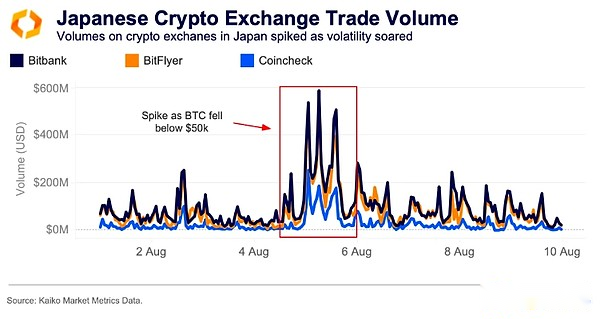
The main reason for the surge in trading volume is the trading activity in the BTC-JPY market, followed by the ETH-JPY and XRP-JPY markets.However, the Japanese cryptocurrency market saw an interesting surge in ETH volume share on Saturday night Japanese time, accounting for more than 30% of the volume at one point.The surge in trading volume occurred the day before most of the volatility coincided with reports that Jump Trading had begun liquidating its ETH positions sparking panic.
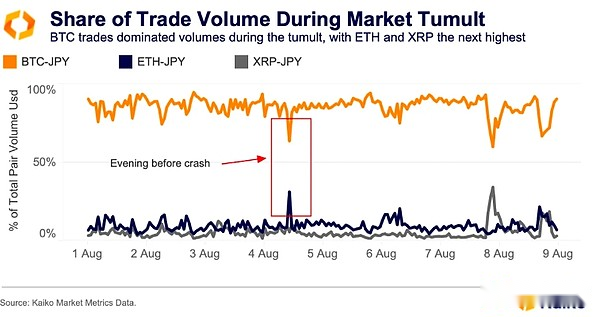
What is the reason behind the Japanese market’s preemptive moves relative to the United States and other major regions?A large part of the volatility in early August was related to yen arbitrage trading.
Arbitrage trading involves traders borrowing an asset (in this case, yen) at a low interest rate and reinvesting it in assets with higher yields, such as U.S. Treasury bonds.Given that Japanese investors are the largest non-U.S. investor group with U.S. Treasury bonds, most people may invest in both assets at the same time.Such investment coincides with the surge in the likelihood of a Bank of Japan hike and the possibility of a Fed rate cut.
When the market is stable, arbitrage trading works best.So when the Bank of Japan raised interest rates for the second time since 2007, the deal suddenly lost its appeal.




